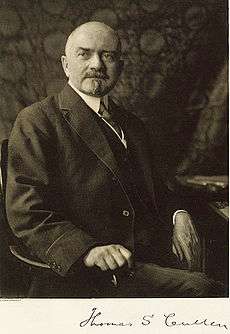Thomas Stephen Cullen

Thomas Stephen Cullen (November 20, 1868 – March 4, 1953) was a Canadian gynecologist associated with Johns Hopkins Hospital.[1]
Born in Bridgewater, Ontario, Cullen was educated at the Toronto Collegiate Institute and the University of Toronto, graduating from the latter school with a Bachelor of Medicine degree in 1890. He began studying at Johns Hopkins University the next year, before traveling to Germany and studying at Johannes Orth's laboratory at the University of Göttingen in 1893. From 1893 to 1896, Cullen was in charge of gynecological pathology at Johns Hopkins, and in 1919 he was named a professor of clinical gynecology.
Cullen researched gynecological diseases including uterine cancer and ectopic pregnancy and promoted extensive use of diagrams in biomedical publishing. Cullen's sign, a discoloration of the skin about the navel which is regarded as a sign of a ruptured ectopic pregnancy, is named for him. He wrote alone, and in collaboration, four important monographs:
- Cancer of the Uterus (1900)
- Adenomyoma of the Uterus (1908)
- Myomata of the Uterus, with Howard Atwood Kelly (1909)
- Diseases of the Umbilicus (1916)
Cullen died at Baltimore, Maryland.[1]
References
-
 This article incorporates text from a publication now in the public domain: Gilman, D. C.; Peck, H. T.; Colby, F. M., eds. (1905). "article name needed". New International Encyclopedia (1st ed.). New York: Dodd, Mead.
This article incorporates text from a publication now in the public domain: Gilman, D. C.; Peck, H. T.; Colby, F. M., eds. (1905). "article name needed". New International Encyclopedia (1st ed.). New York: Dodd, Mead.
- 1 2 Scottish Rite (Masonic order). Supreme Council for the Southern Jurisdiction (1953). The New age magazine. Supreme Council, 33,̊ Ancient and Accepted Scottish Rite of Freemasonry of the Southern Jurisdiction, U.S.A. p. 256. Retrieved 12 March 2012.